Niki de Saint Phalle’s SoCal Dreams
by Yann Perreau
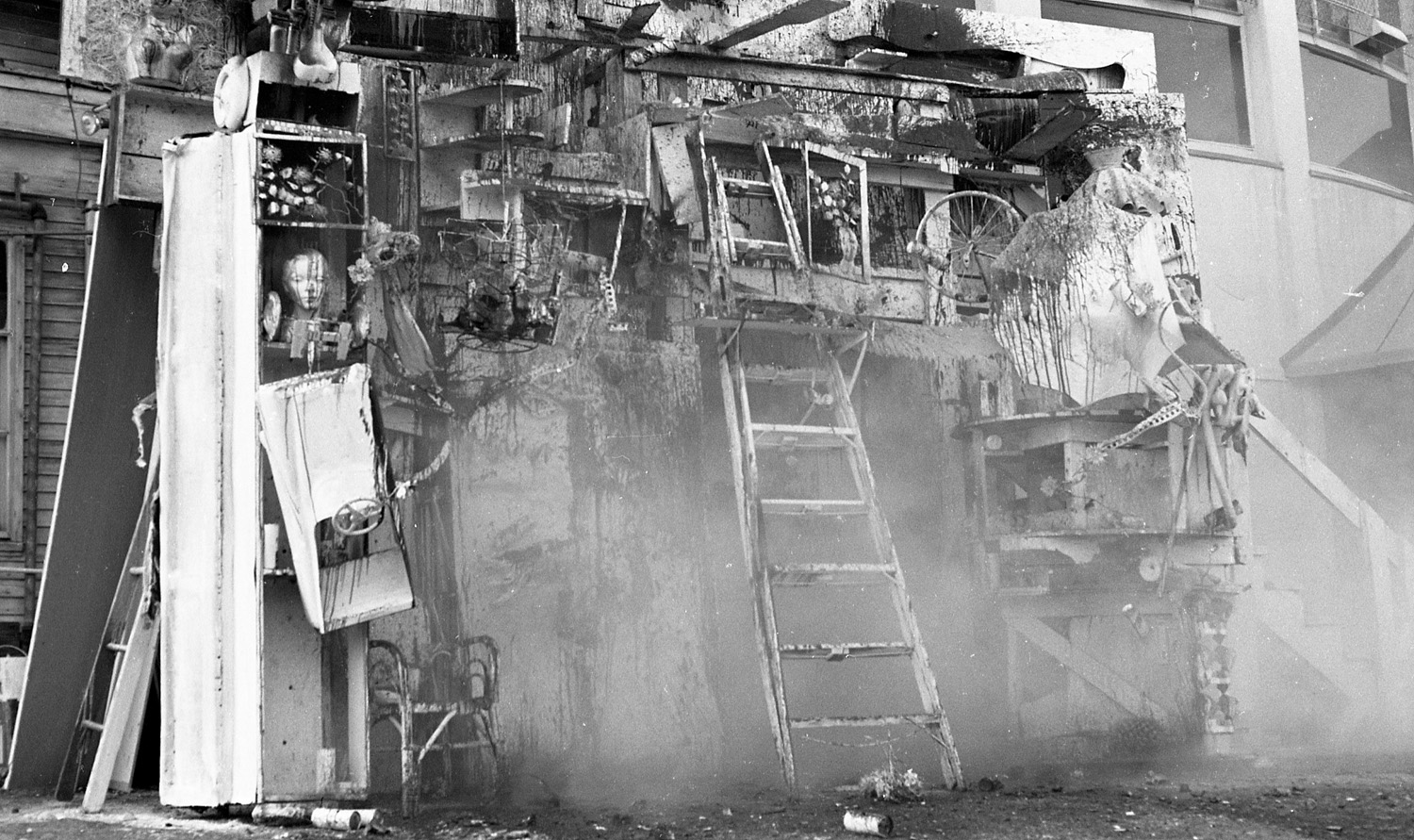
Niki de Saint-Phalle, Action de tir, 1962. Performed at the Everett Ellin Gallery, Los Angeles, CA. Photo: Seymour Rosen. Courtesy of the Estate of Seymour Rosen and SPACES, Aptos, CA.
Los Angeles, March 4, 1962: Niki de Saint Phalle orchestrates the first of her series of Tirs, or “shooting paintings,” in the U.S. in a parking lot behind a jazz club on the Sunset Strip. Dressed in all white and carrying a .22 long rifle, she climbs a ladder and aims at the tableau ahead—a vast assemblage, spanning over twenty feet, which is also completely white. It is constructed of disparate plaster sculptures, including a snake toy and a dragon, filled with bladders of paint that explode when she shoots, breaking open into wild dispersions of colors and textures. The work starts to bleed.
Edward Kienholz, Saint Phalle’s assistant for the performance, reloads the rifle round after round. The audience, which includes Robert Rauschenberg, Arthur Secunda, Leo Castelli, John Cage, writer Lawrence Lipton, and gallerist Walter Hopps, applauds. After she descends the ladder, Lipton confronts her: “It’s marvelous,” he comments, “but, you realize, you are just an exhibitionist?” She replies sarcastically, “But of course.”1
After decades of underestimation echoing Lipton’s snobbery and sarcasm in 1962, Niki de Saint Phalle (1930-2002) has finally gained a considerable reconsideration—some would say a rebirth—supported by significant museum exhibitions worldwide and notably in the USA.2Saint Phalle was a key figure of the Nouveaux Réalistes (New Realists), an art movement founded by critic Pierre Restany in 1960, which included, among others, Yves Klein, Arman, César, Christo, Jean Tinguely, and Daniel Spoerri. The Nouveaux Réalistes advocated for “new ways of perceiving the real” (as proclaimed by Restany in his group manifesto, the “Constitutive Declaration of New Realism”) and advocated a return to “reality” in opposition to the lyricism of abstract painting. Restany defined Nouveau Realisme as a “poetic recycling of urban reality, industrial, advertising.”3
The only female artist of the group, Saint Phalle perfectly illustrated this idea with her “shooting paintings.” In a time when contemporary artists were expected to eschew the personal in favor of the abstract and the universal, she was brave enough to expose her lived experience. Her convictions, fears and hesitations, wildest dreams and deepest traumas were the very substance of her work—what she would deconstruct and shoot at in her performances. She could have never done it differently, art being for her a radical survival strategy that saved her from committing suicide when she suffered from depression in her early twenties.4Publicly addressing personal traumas and inviting an audience to witness all your anger and your frustration in a staged performance was indeed uncommon at that time, especially for a woman, and could have been dismissed as “exhibitionism” in the art world of the early 1960s. But Saint Phalle was brilliantly expanding the new realism project of “bringing life and art closer together.” It was also an explicitly feminist political gesture, an “extension of the ‘personal is political’ clarion call of the [second wave] feminist movement,” as art historian Amelia Jones puts it.5
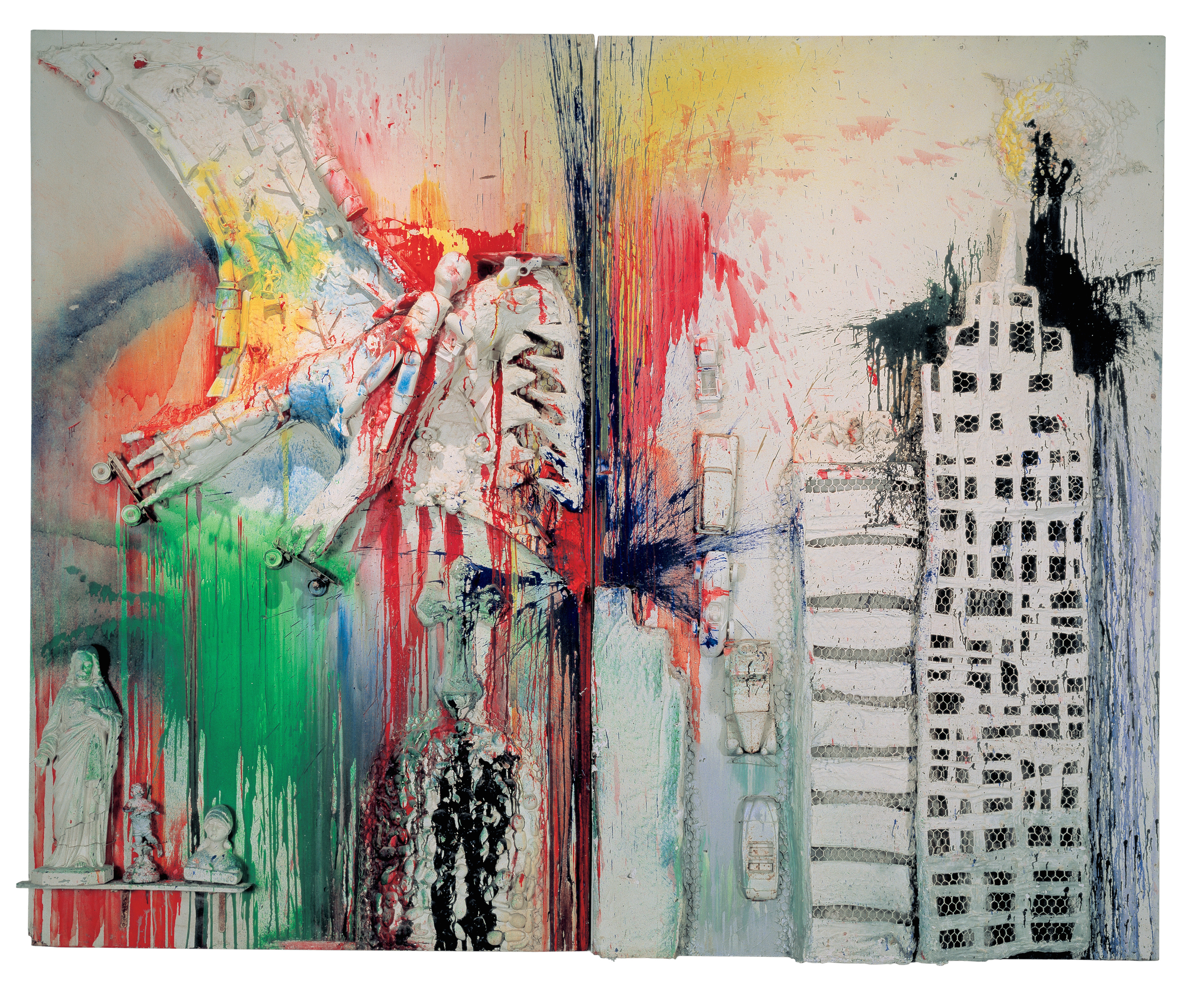
Niki de Saint Phalle. Pirodactyl over New York, 1962, collection Guggenheim Abu Dhabi © 2024 NIKI CHARITABLE ART FOUNDATION, All rights reserved. Photo © Laurent Condominas
“The Nouveaux Realistes consider the World as a Painting, the fundamental Great Work from which they appropriate fragments endowed with universal significance. They allow us to see reality in aspects of its expressive totality,” wrote Pierre Restany in the manifesto he published in April 1960 on the occasion of the first collective group show of the movement in Italy at Galerie Apollinaire. These words keep coming to my mind as I reflect on Saint Phalle’s work. The artist knew very well how to play with her image. A former teen model, she appeared on the cover of Life magazine in 1949 at the age of 18.6Glamorous and charming in her modeling career, she went the opposite direction as an artist, creating in her early works raw, lacerated paintings haunted by sinister, sometimes faceless, figures.
Many people were skeptical, if not shocked, to see this conventionally attractive young woman shooting a rifle at not only plastic toys but also religious artifacts, figures of men, and even heads of state. The American journalist David Brinkley, who went to Paris to attend her Tirs at Impasse Ronsin, commented in his NBC reel, “Those who work in these violent, physical, even athletic art styles say the act of creation itself is what counts—the making of the picture, not the picture itself.”7
A key aspect of this work for Saint Phalle was audience participation; she would invite those present to shoot for themselves. “I go through this elaborate structure that I make and I want the people to color my world, what I’ve made,” she explained to critic Dorothy Gees Sekler. “I began by having other people shoot at them…and then I started shooting at them myself afterward, when the results were—oh, maybe I wanted to bring it back more to myself.”8Her series of shooting paintings is now understood as an original response to Jackson Pollock’s drip paintings (“dripping au revolver,” Restany once famously said) 9as well as an innovative interpretation of Duchamp’s readymades. They are reconsidered alongside the happenings staged by her American contemporaries Claes Oldenburg and Allan Kaprow, as shown by a 2022 exhibition at the Menil Collection in Houston and Museum of Contemporary Art San Diego entitled “Niki de Saint Phalle in the 1960s.”
In 1961, Saint Phalle attended Oldenburg’s scripted versions of these happenings at his Ray Gun Theater on East 2nd Street in New York. She was impressed, though slightly critical of its “shut” dimension, as Michelle White, the Menil Collection’s senior curator who co-organized the pivotal 2022 survey, explains. The audience was there only to witness, not to participate. That same year she attended Kaprow’s performance at the “Movement in Art” exhibition at Moderna Museet in Stockholm and found in it a key source of inspiration. Museumgoers entered a gallery filled with cardboard boxes that could be altered and manipulated by the visiting public. “They could stack, paint, sculpt, hang, or do anything they wished with the boxes,” describes White.10Derived from the rites of American action painting, Kaprow’s performances were also an homage to Pollock. They allowed for unplanned outcomes, and Saint Phalle pushed this idea one step further with her “shooting paintings.” Not only did the public participate in the shootings, but they also created a collective work with their individual emotions. Participants had the choice of what and how they shot within the work, but when her paintings bled, they bled collectively. Between 1961 and 1963, Saint Phalle made eleven Tirs before stopping abruptly because, as she explained, “I became hooked on this macabre yet joyous ritual. It got to the point where I lost control.”11

A general view of the stage showing the works by Jasper Johns and Niki de Saint Phalle, with Robert Rauschenberg still painting. Jean Tinguely and the marksman are seen standing on the far right. David Tudor performance of John Cage’s Variation II, Théâtre de l’Ambassade des États Unis, Paris, 1961 June 20. Artwork © Niki Charitable Art Foundation, all rights reserved. Getty Research Institute, Los Angeles (2014.R.20) Gift of the Roy Lichtenstein Foundation in Memory of Harry Shunk and Janos Kender. Photograph: Shunk-Kender © J. Paul Getty Trust
The Nouveaux Réalistes are generally presented as the French counterpart to American Pop art, but these artists related on a more personal level to Robert Rauschenberg, Jasper Johns, and Larry Rivers, with whom they had strong ties of friendship. Born in Paris and raised in New York, Saint Phalle was key in this dialogue between the two sides of the Atlantic, frequently collaborating with her American compatriots in Paris and participating in the group’s projects, exhibitions, and performances. During the notorious multimedia event Homage to David Tudor, which took place at the U.S. Embassy in Paris on June 20, 1961, a “striptease machine” was activated by Tinguely while a barefoot Rauschenberg painted a canvas with his back turned to the audience, his brush connected to a microphone to amplify the sounds of his movement. Meanwhile, Tudor himself played John Cage’s highly experimental Variations II on the piano, Jasper Johns contributed a target made of flowers and announced an intermission that never occurred, and a marksman shot at Saint Phalle’s assemblage for a startled, unamused audience. “The audience,” recalled Saint Phalle, “hissed and booed, and many people left before the end. We found the hostility and anger stimulating.”12Darthea Speyer, who organized the event, described how she was “highly criticized by U.S. Information Service officials and forbidden to organize anything similar again under any circumstances.”13
Saint Phalle maintained a close relationship with Robert Rauschenberg, an intimate friend and co-creator who attended and participated in seven of Saint Phalle’s Tirs between 1961 and 1963.14Remembering those works in a 1997 interview, Rauschenberg reflected that he liked the feeling of surprise when colored paint emerged on the “neutral” surface and admired that it was “through the course of action that the art takes form.”15Saint Phalle “shared his interest in the core tenets reshaping art, the reorientation of the picture plane, but also notions of the ephemerality; the intersection of performance, painting, and found objects; and the breaking down of distinction between art and life through collaboration,” writes White.16The two artists worked together on various projects, including Painting Made by Dancing (1961), a huge “all-over” painting that was created in collaboration with the audience who attended the after party of the aforementioned “Movement in Art” Stockholm exhibition. Saint Phalle and Rauschenberg laid a canvas under the dance floor, and under this canvas, as in Saint Phalle’s Tirs, they placed balloons filled with paint that popped through the fabric as the audience danced to live jazz played by Thelonious Monk. Many texts about this work exclude Saint Phalle as a symptom of the sexist approach towards female artists that has dominated art history for so long.17Saint Phalle has at times been reduced to “the girlfriend of Jean Tinguely,” the Swiss artist who became her second husband. Her work has been caricatured, in stereotypical fashion, as something that had more to do with personal trauma, female hysteria, or the emotional than with the highly conceptual or being in dialogue with her peers and the history of art. An “exhibitionist,” as Lipton had put it.
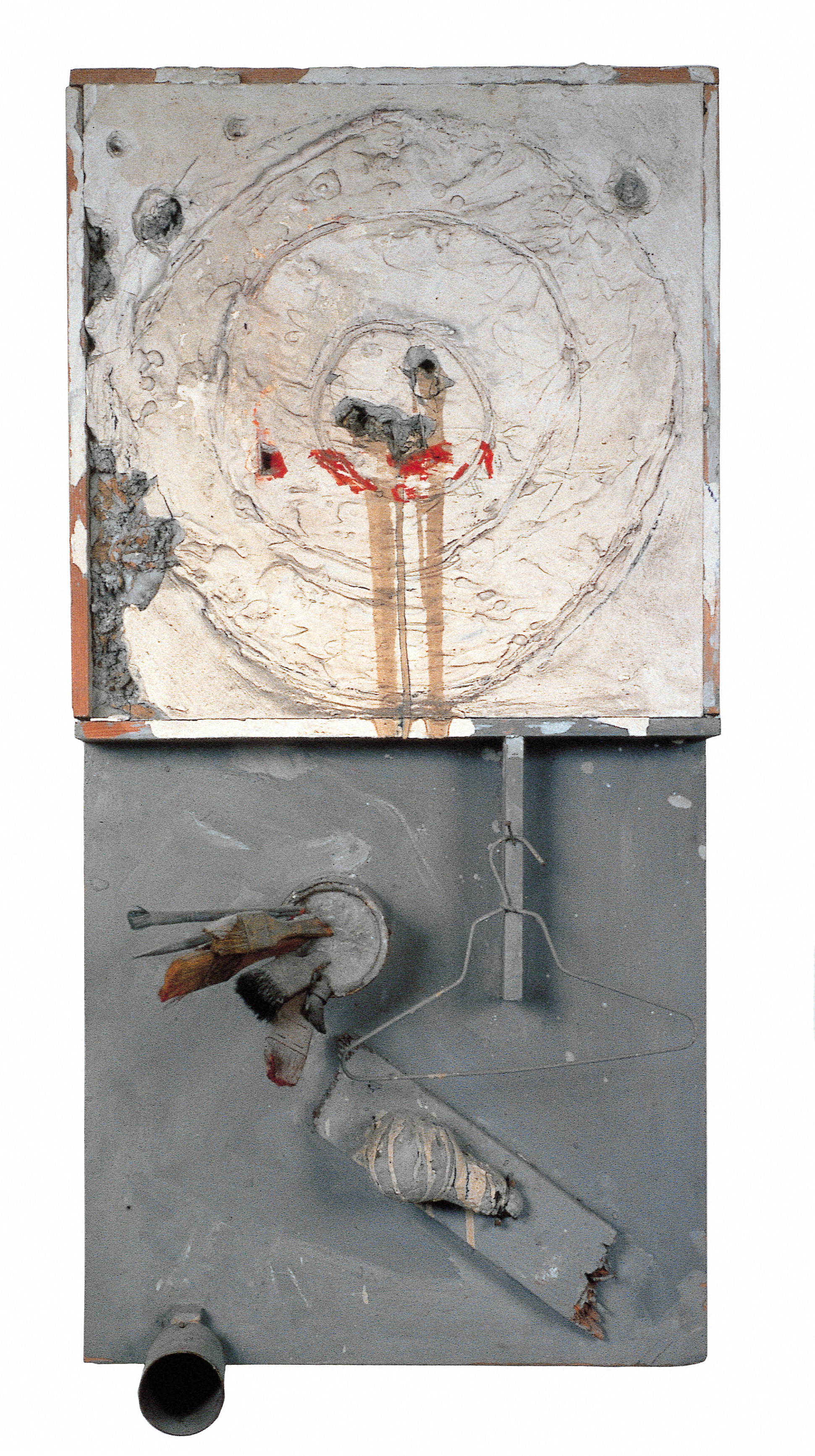
Niki de Saint Phalle. Tir de Jasper Johns, 1961, collection Moderna Museet Stockholm © 2024 NIKI CHARITABLE ART FOUNDATION, All rights reserved. Photo © Laurent Condominas.
Saint Phalle’s relationship with the United States was complex and sometimes conflicted. In her 2006 autobiography Harry and Me, 1950-1960: The Family Years, she explains why she and her first husband, the writer Harry Mathews, left America for France: they wanted to escape McCarthyism, the lynchings, and the psychosis of the nuclear bomb. It was in Paris where she fully immersed herself in her artwork, inspired by the art of Paul Klee, Henri Matisse, Pablo Picasso, and Henri Rousseau as well as Jasper Johns, Willem de Kooning, Pollock, and Rauschenberg. Invited to participate in “The Art of Assemblage” at the Museum of Modern Art in New York in 1961, she moved into the famed Chelsea Hotel with Jean Tinguely (she had split with Matthews in 1960). She became known in her birth country and was promoted by the gallerist Alexandre Iolas, who gave her a solo exhibition in 1962.18In February of this same year, Saint Phalle and Tinguely visited California. The late arts advocate Lyn Kienholz, who was very close to her and Jean Tinguely, described for me the day when the couple discovered Simon Rodia’s Watts Towers in South Central Los Angeles and its decisive impact on Saint Phalle.19Rodia, an Italian immigrant and eccentric self-taught artist who considered himself a masonry worker first, swiftly joined Saint Phalle’s canon of heroes alongside Antoni Gaudí and Ferdinand Cheval. Rodia’s total dedication to a masterpiece work, which he spent 30 years building alone and sculpting by hand, pointed to a compulsive hold on the life force that had propelled Saint Phalle from the start.20Rodia’s achievement in the massive network of sculptural towers and mosaic works allowed her to dream of utopian structures and later inspired her to create two monumental sculpture gardens, Jardin des Tarots in Tuscany in 1979 and Queen Califia’s Magic Circle in California in 2003.
The Nouveaux Réalistes weren’t very successful or happy in New York. Martial Raysse told me about his frustration then, how he and his European peers felt misunderstood, and how a faulty comparison with Pop Art became a sort of unfair competition.21Leo Castelli infamously didn’t sell a single work from Yves Klein’s show at his New York gallery in 1961, though the young French artist was the rising star in the European art scene at the time. On the other hand, Los Angeles became for the Nouveaux Réalistes gang a place to experiment and reinvent themselves, a “blackboard” away from the art market and the conventions of Paris and New York. The late arts patron and gallerist Virginia Dwan, who exhibited Saint Phalle in her eponymous L.A. gallery in 1963, had said to me, “A New Yorker most of her childhood, Niki discovered with amazement the Wild West.”22While the Nouveaux Réalistes hit a wall in New York, they fit perfectly with the wild, voracious, and fun spirit that dominated the birth of the art scene in Los Angeles then. They quickly found their way into the burgeoning community of artists.23
Saint Phalle had something else, I believe, that related her to Los Angeles and Hollywood: a delirious combination of sex appeal and violence. “War without victims…” as she once said about her work, “Only a woman could use those destructive contraptions that man has imagined for a constructive end, and that’s beautiful.” Los Angeles became an ideal stage for the performance artist she was aspiring to become, blending the worlds of visual arts, avant-garde cinema, and fashion. Here her works became successful beyond the small art world circle of that time, reaching actors and directors like Jane Fonda and Dennis Hopper—Fonda participated in the performance that was organized in the Malibu Hills in 1962. Saint-Phalle was the “Annie Oakley of the palette,” as Fox Movietone News described her after the famous American sharpshooter: a new incarnation of the iconic femme fatale brandishing a firearm. In a press statement preceding the release of his 1964 caper film Bande à part (Band of Outsiders), Jean-Luc Godard quoted D.W. Griffith, declaring, “What do filmgoers want? A girl and a gun.” A year later in Hollywood, Fonda starred as a glamorous woman with a gun in Elliot Silverstein’s Cat Ballou, the mainstreaming of an idea first explored in the avant-garde circles of Paris four years earlier.
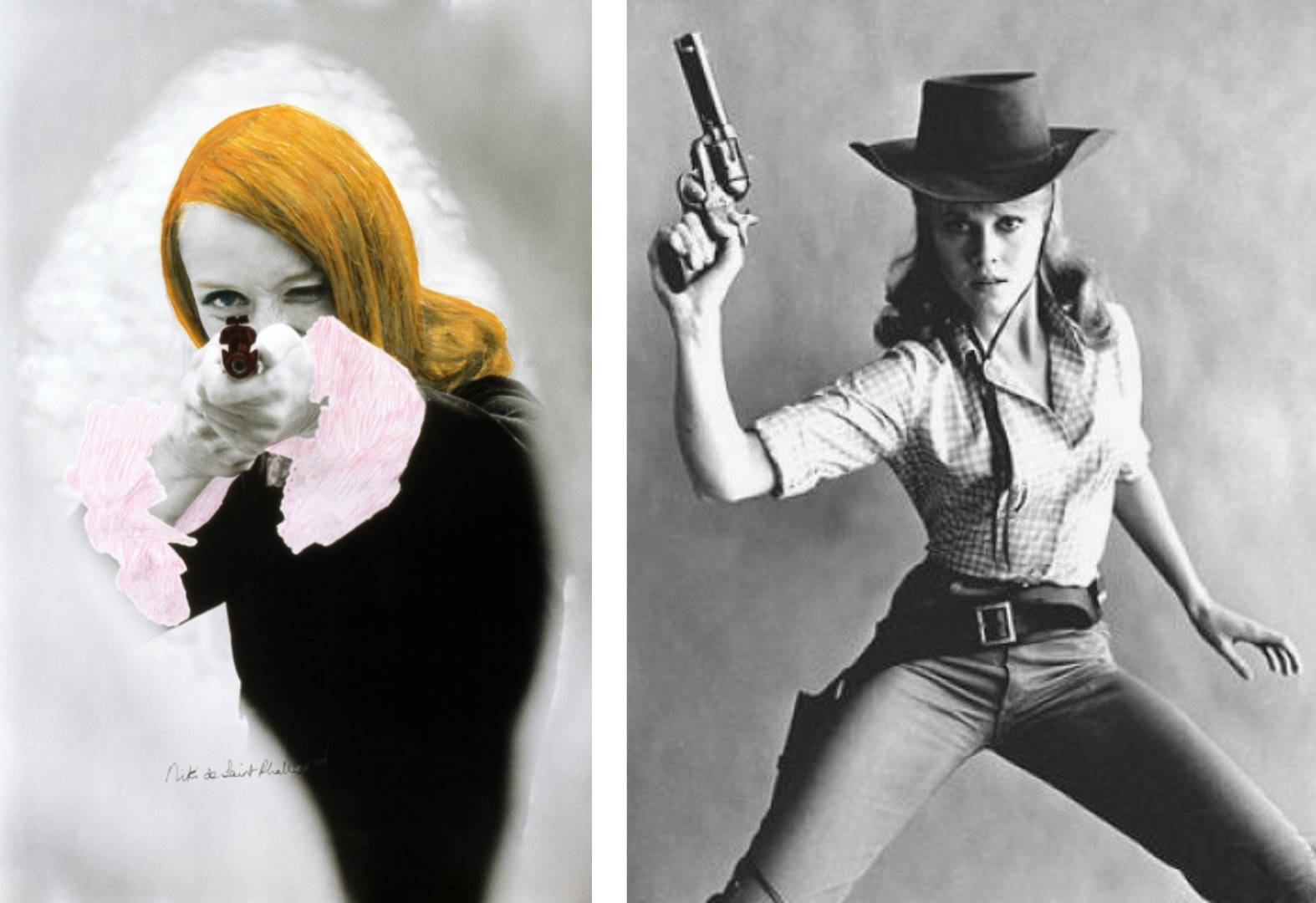
Left: Niki de Saint Phalle shooting (colored Film-Still of “Daddy”), 1973 © 2024 NIKI CHARITABLE ART FOUNDATION, all rights reserved. Photo: Peter Whitehead / Right: Jane Fonda in a promotional photo for Cat Ballou (1965) directed by Elliot Silverstein.
Virginia Dwan also remembered Saint Phalle and Tinguely combing through downtown Los Angeles for days in search of junk shops, supply stores, and supermarkets looking for material for their works: “She was looking for a lot of nasties like rubber spiders and alligators and snakes and skeletons and so forth.”24These artifacts were ideal for the two artists’ search for a “poetic recycling of urban, industrial and advertising reality.”25Together they composed the tableau created for the Tir staged in the Malibu Hills in May 1962. This was an enormous, four-paneled assemblage propped up like a billboard or movie screen. A bird cage containing a live bird was added to the composition (the animal avoided the bullets and ultimately survived the event). A year later, for her exhibition at Dwan Gallery, Saint Phalle composed a new five-paneled tableau spanning 20 feet before shooting at it. The work is rich with references to film, pop culture, and political debates of the time—after the Cuban Missile Crisis, its title, King Kong, carried with it direct associations to the atomic bomb.
The composed scenes are gloomy and dystopic: Godzilla looms over Manhattan, while airplanes drop bombs from the sky. Molds of the heads of Nikita Khrushchev, John F. Kennedy, Fidel Castro, Charles de Gaulle, and even Abraham Lincoln seem to float mid-air before falling into pieces during the shooting. “She pretty much created a scandal with this work, which was her aim,” her granddaughter Bloum Cardenas, who runs the Niki Charitable Art Foundation, told me.
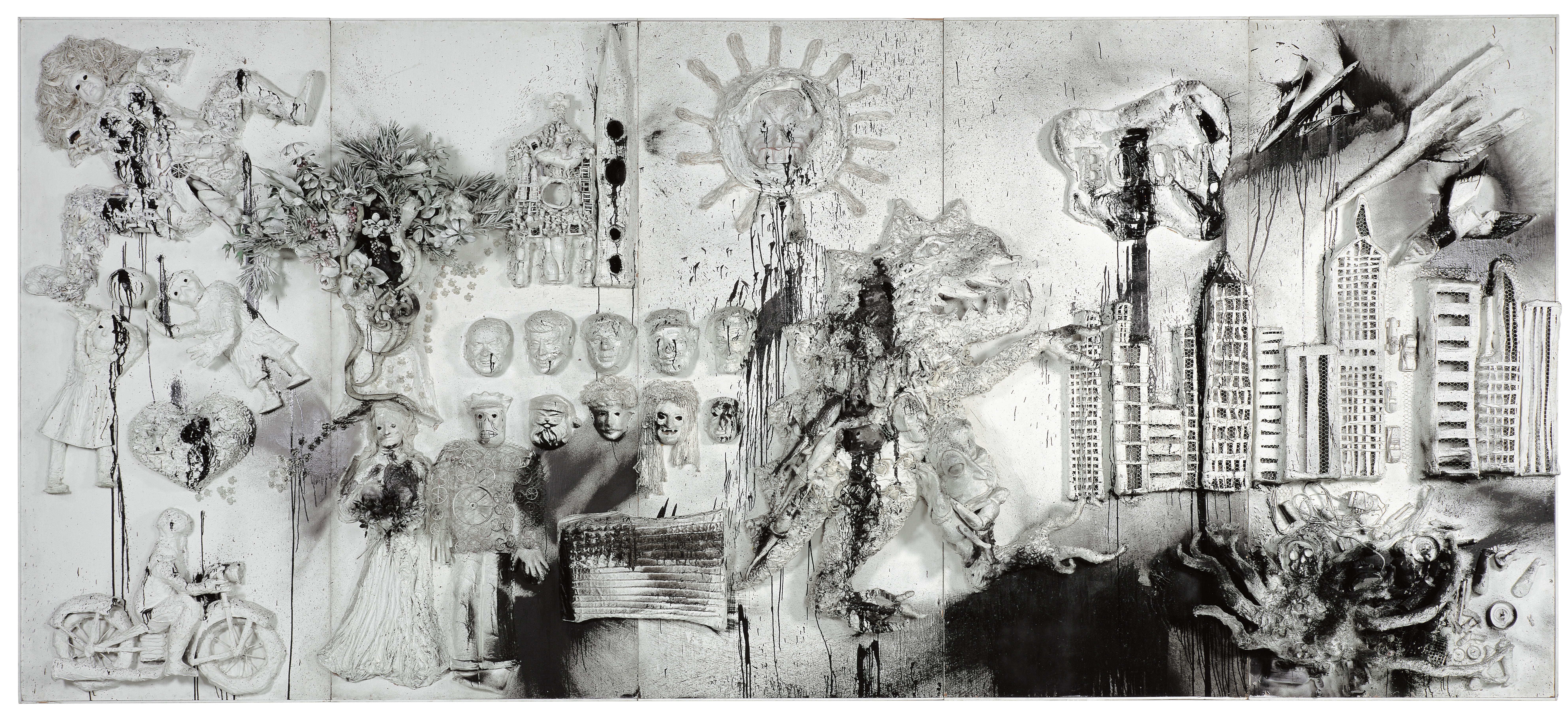
Niki de Saint Phalle. King Kong, 1963, collection Moderna Museet Stockholm © 2024 NIKl CHARITABLE ART FOUNDATION, All rights reserved. Photo © Laurent Condominas
The intensity and the violence that I still feel every time I look at Saint Phalle’s Tirs never seem to be apologetic but rather pointed at a specific target, truthful in respect to the artist’s intention: each of her eleven Tirs paintings was a crucial, necessary gesture, “a matter of life and death,” she confessed at some point. “I was getting a kick out of provoking society through ART,” she writes. “No victims. […] I was shooting at my own violence and the VIOLENCE of the times.”26Saint Phalle’s works transcribe viscerally the spirit of the time and place where she decided to live or work. In King Kong, she evokes Susan Sontag’s “The Imagination of Disaster” essay which, according to Mike Davis, defines Los Angeles (the city, argues Davis, has been destroyed no less than 138 times in novels and films since 1909).27This postwar landscape which characterized the Golden State, with its aerospace and military infrastructures, is what Saint Phalle explored with fascination and worry as she drove around with Tinguely.28Saint Phalle supported Tinguely as the assistant and translator in his creation of the exhilarating Study for the End of the World No.2 (1962) in the Nevada desert, a choreographed performance where objects and vehicles exploded one after the other, detonating in front of an audience gathered on vacant land outside Las Vegas.29
The project was originally commissioned for NBC’s David Brinkley’s Journal as a nationally televised news feature about Tinguely and Saint Phalle’s work. Working from their room at the Flamingo Hotel on the Strip, the couple assembled the “plastic bombs” necessary to blow up the sculptures, which they built over four days within the casino hotel’s parking lot, specially cordoned off for them to work in privacy. They then drove their creation out in a motley caravan and set up on a dry lakebed in a ramshackle configuration with multiple cables and wires leading to the makeshift control booth. After a few unexpected delays, the entire piece was blown up in an hour, in a scene that seems to prefigure the famous ending of Antonioni’s 1970 film Zabriskie Point, featuring a five-minute sequence in slow motion in which a house with all its belongings—fridge, television set, food, clothes—explodes into kaleidoscopic colors and forms.30Bloum Cardenas recalled the huge number of dynamite sticks the two artists carried in their hand luggage on the plane to Las Vegas, fearing for the worst when the passenger sitting next to them lit a cigarette. The philosophy and constant mood of these two, later described as the “Bonnie and Clyde of contemporary art,” were subversion and humor, youth, and spirit.31Their Dada enactments were in tune with the Sixties cultural revolution and the West Coast art scene.
Inspired by the pregnancy of Larry Rivers’s wife Clarice, Saint Phalle made her first Nanas in 1965. These archetypal female figures, updated versions of the “Every(wo)man” (nana is a French slang term for girl or girlfriend), became central in her work, which she explored in various mediums. First exhibited as artist’s books, with hand-lettered graphic works in the form of invitations, posters, books, and other writings, they inspired her to create large-scale sculptures. In 1966 she created Hon (Swedish for “she”) for Moderna Museet, a building-sized giant reclining Nana with an interior environment entered from between her legs which garnered worldwide attention. She developed other fantastical architectural projects, such as Golem, an outdoor public sculpture for children in Jerusalem’s Rabinovitch Park in 1972. In the late 70s, Italian friends offered her 14 acres in Tuscany so she could realize a long-held dream to create a whimsical sculpture park inspired by Antonio Gaudí’s Park Güell in Barcelona. This became the Tarot Garden, a densely wooded hillside rising from the neighboring farmland populated by brightly-colored monsters embodying figures from the tarot deck alongside versions of her own Nana figures, voluptuous goddesses with shimmering skins of ceramic tile, glass, and mirror. For several years during the early 80s, Saint Phalle lived inside the largest of these, The Empress, a great sphinx-like head with a cavernous interior that served as home and studio. But the American Southwest, with its wild nature and free spirit, remained a constant source of inspiration. From time to time, she would feel the need to go to the desert to find herself again. “I dreamt I was in Arizona,” she wrote in one of her diaries from the 1970s. The desert landscape and its folklore, inhabited by scorpions, mustangs, cacti, and other mythological creatures became recurring tropes in her work.

Visitors to HON, Moderna Museet, 1966. Artwork © Niki Charitable Art Foundation, all rights reserved. Photo: © Hans Hammarskiöld. © Hans Hammarskiöld Heritage
In 1983 she designed a series of prints for a project to support the Temporary Contemporary in Los Angeles. This work, in the form of a pictographic letter, expresses her early awareness and concern for those afflicted by AIDS. “Los Angeles is going to have its Museum of Contemporary Arts and its own ballet company!” she wrote enthusiastically from Malibu to her dear friend, the aforementioned Clarice Rivers. Her friend and close advocate Pontus Hultén, who had offered critical early support at Moderna Museet, didn’t last as the first director of MOCA—exhausted after four years of constant fundraising and infrequent exhibitions, he returned to Europe in 1984, potentially dashing Saint Phalle’s hopes for greater support in Los Angeles. But that same year, the Stuart Foundation commissioned Sun God, her first outdoor sculpture commission in America for the campus of the University of California at San Diego. Today Sun God has become today a landmark on UCSD campus. Students have at various times decorated the statue with giant sunglasses, a cap and gown, a UCSD ID card, and a nest of hay with eggs. An annual springtime Sun God Festival has emerged as one of the countless spontaneous responses which embrace the sculpture as a campus character.
Jean Tinguely died in 1991, leaving Niki profoundly bereft. The next year she decided to establish herself in San Diego, “Resurrection in La Jolla!” she writes in her diary. “Health, joy and curiosity for life came back with a BANG.” Her move to the West Coast was also for health reasons—she suffered from heavy respiratory complications due to her lifelong inhalation of toxic paints. La Jolla, with its pure air and world-renowned doctors at the Salk Institute, proved ideal for her condition. “I was rejuvenated by the open spaces, the desert, the ocean, leaving my past life, starting over. […] It’s never too late to learn! In Southern California, I became a sponge, permeable to the sea, mystery, immensity of nature, trees, air, animals, earth, sand, people.”32
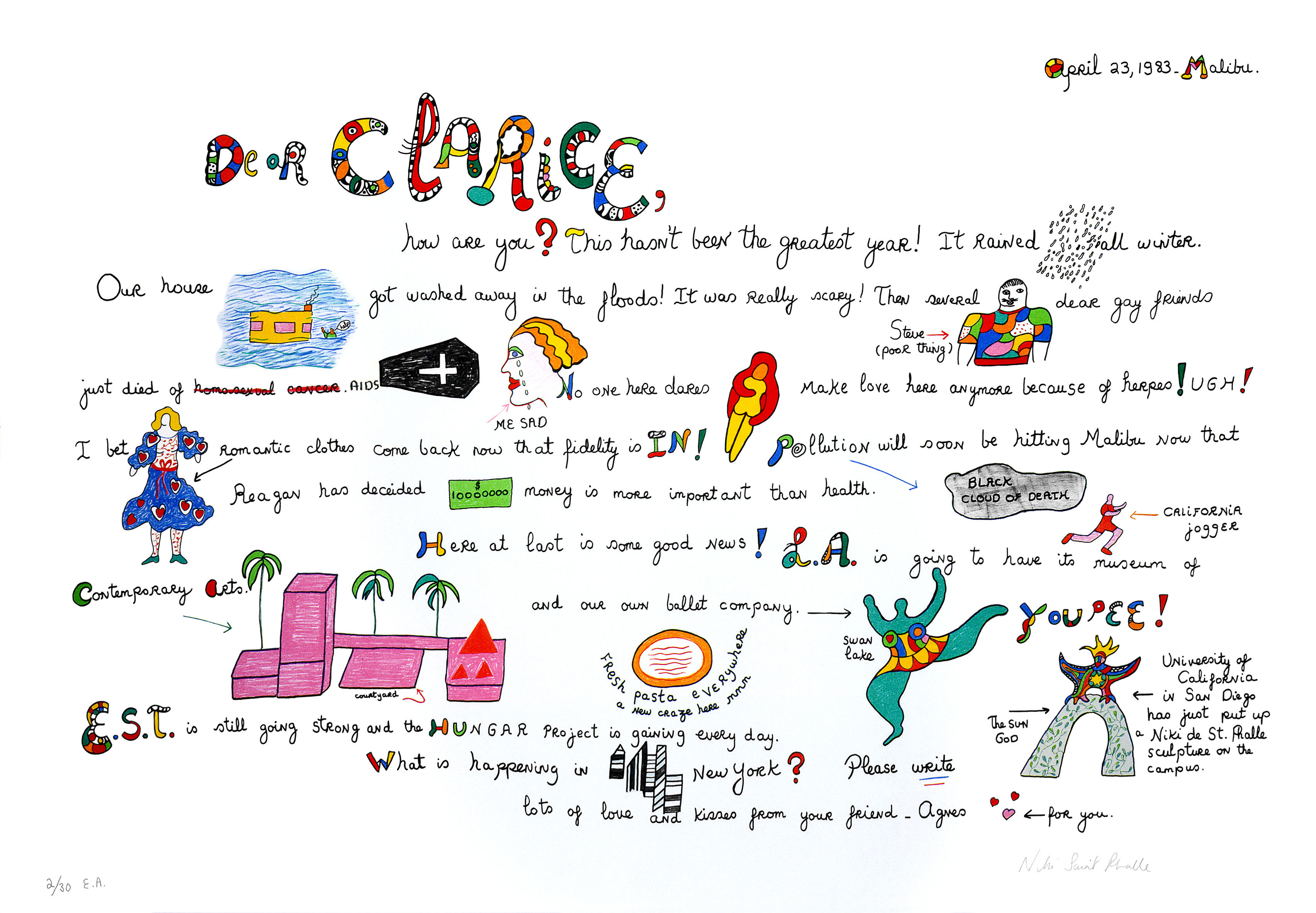
Niki de Saint Phalle. Dear Clarice, 1983 © 2024 NIKI CHARITABLE ART FOUNDATION, all rights reserved. Photo: unknown

Niki de Saint Phalle. Global Warming, 2001 © 2024 NIKI CHARITABLE ART FOUNDATION, all rights reserved. Photo: Ed Kessler
The works she created at that time and in the last few years of her life strongly resonate with contemporary politics. In 2001, after George W. Bush’s election, she created a series of four rarely-seen political lithographs. In Guns (2001), she condemns the National Rifle Association, a coherent fight for an artist who denounced the banality of violence through the use of guns in her early performance works.33With gory details, she illustrates terrible fatalities which still frequent today’s headlines.
In Abortion-Freedom of Choice (2001), she defends women’s rights on her own terms, covering topics from starvation in overpopulated countries to a lack access to birth control.34 Her lithographs also conveyed worry over global warming and the AIDS epidemic. Her 1994 California Diaries silkscreen collection (created at Litho Shop, Inc., Sam Francis’s lithography and etching studio in Santa Monica) remains her most accomplished graphic works, from representing the Statue of Liberty as a beautiful, joyous, and powerful figure in psychedelic colors in Order and Chaos to Queen Califia, which recounts her encounter in the desert with the mythological Amazon queen and freed slave who, according to a forgotten myth, is behind the origin story of California.
Califia appeared to her in the desert, recalls Saint Phalle, to require that she build a temple for her. The artist kept her word, spending the final years of her life creating her last major work, Queen Califia’s Magical Circle, which opened in the city of Escondido in 2003, a year after her death. A 400-foot long undulating circular wall surrounded by monumental serpents decorated in patterned mosaics, nine large totemic sculptures covered with symbols and forms freely drawn from Pre-Columbian, Mexican, and Native American references, and native flora. Saint Phalle created nine other public works in Southern California from 1983 to the early aughts, including her Le Poète et sa Muse (1978) sculpture at the Mingei International Museum in San Diego. The artist died on May 21, 2002, at the age of 71 in La Jolla, California. In the last of her engravings, created in memory of the deceased son of a friend, she wrote, “Death does not exist. Life is eternal.”
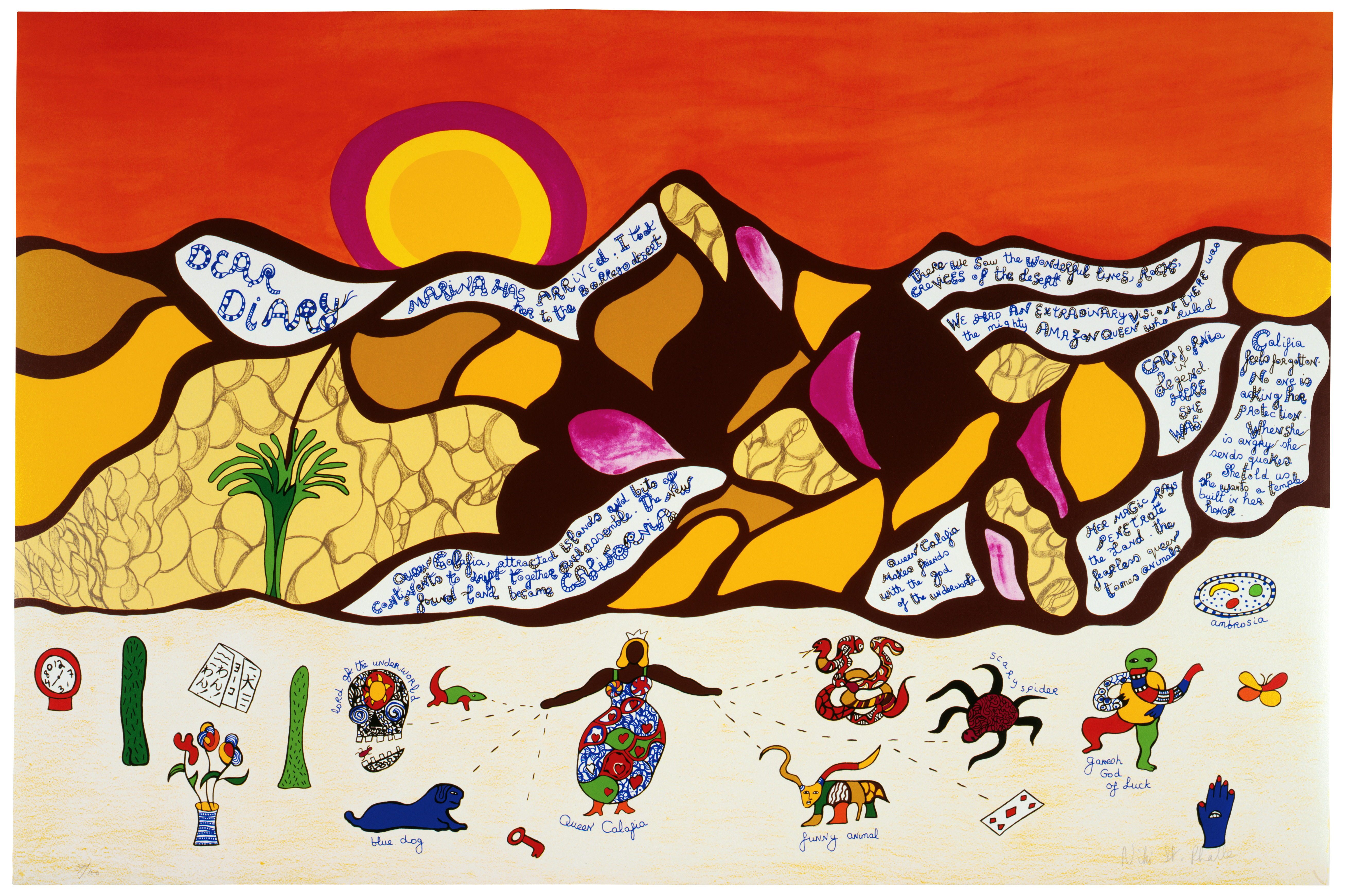
Niki de Saint Phalle. Californian Diary (Queen Califia), 1994 © 2024 NIKI CHARITABLE ART FOUNDATION, all rights reserved. Photo: Ed Kessler